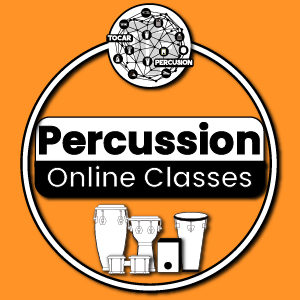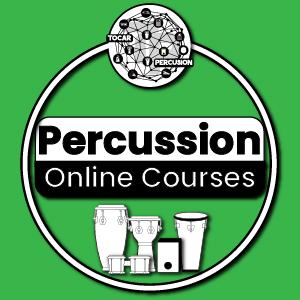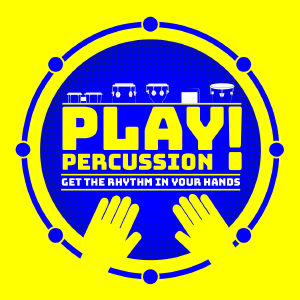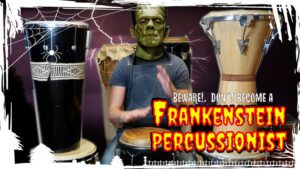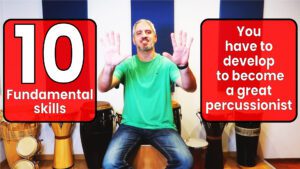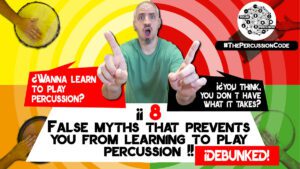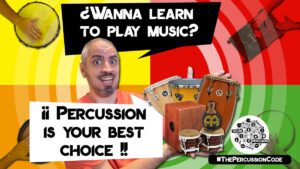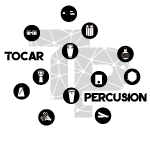Start your learning path in percussion today!
Learn to play percussion from scratch, Ultimate Beginner’s Guide
Author: Facundo Alvarez, Percussion teacher and Facilitator
The key is to have a learning path
When we first approach and start to learn to play a musical instrument everything is new and challenging to us. In general we find ourselves out of our comfort zone and that make us feel kind of uncomfortable.
Anything sounds like what we expected.
There is no connection between our hands and our brain.
Everything seems wrong and out of place.
So, when we sit down to play our instrument a lot of doubts arise and make us hesitate about our playing skills.
And that feels like we´re juggling with several things at the same time: Hand technic, Pulse, Melody, Percussion Ensemble, etc.
I know it´s a lot. But Don´t worry, that feeling doesn’t last forever.
Actually, the progressive practice with your instrument is going to help you to improve your playing in a way that most of the things that currently take a lot of thinking to make are going to become organic and natural to you.
So my first advice is “Be patient”.
The learning path you´re about to begin is a process and requires time.
The most important thing you have to understand is that each one of us has different needs and learning pace, so don’t push yourself too hard and try to have fun and enjoy your own learning path in percussion.
The key element of this organization is to have a Learning Path, which is the step by step route you have to go through to get the knowledge and the abilities to move forward from our initial point, in general it´s start learning from scratch, to final point in which we achieve to goal we´re seeking with our percussion instrument, maybe is learning play a rhythm or a song, or both. In any case we´re going to need a Learning Path to achieve it.
However, learning percussion or any other instrument is a progressive, cumulative and incremental process. What I mean is, once we start our learning path, as we progress in it, each new knowledge and skill that we acquire in one step is going to become the base to develop the one we are going to acquire in the following.
Organize your practice routines around short and achievable goals
One fundamental element we forget about when we start a learning process is motivation.
It’s always important to have a clear goal that makes us move forward in our learning path and that gives sense to all the activities we do in our practice sessions.
However, sometimes we set very long goals and after a while they become unattainable and instead of motivating us they make us feel frustrated.
To avoid that to happen, one strategy I recommend is dividing that big goal into a series of smaller goals that we can achieve easily and in a smaller time.
In this way, we´re going to be able to achieve several little goals that are going to keep us motivated along our learning path.
Priotitize quality over quantity in your times of practice
There is a well known maxim that says that “Practice makes the master”.
However, this is a half true because we can say it’s true that practice is what guarantees us success in what we set out to learn, but this maxim leads us to several question such as:
How much time do I have to practice?. How often?. With what intensity?
Again, before quantity you have to seek for quality in the time you dedicated to learn and practice with your instrument. Be sure that in a 30 minutes of focused and dedicated practice, without any interruption, you´re going to get better results than a 2 hours unfocused and unorganized practice session.
Always learn the simple first and then tackle the complex
In any learning process, the optimal way of learning is to start from the beginning. What I mean, start simple and then step by step move forward gradually into learning more complex knowledge and skills
When you face some difficulties in playing the rhythm of a rhythmic exercise, what you have to do it´s stop and take some time to see why you can’t play it.
Keep hitting the same obstacle it has no sense. Also wait to overcome that difficulty miraculously. It’s just not going to happen
Instead when you stop and take a time to see what’s wrong it is going to allow you to identify which aspects are the ones that prevent you from playing that: the hand technique, the musical or the rhythmic ones. In that way you´re going to be in a better place to solve the problems and achieve to play it.
Learn to play percussion online
¡Choose the way to learn to Play Percussion
that best suits your times and needs!
Learn to Play Percussion: Bongó, Conga, Cajón, Djembé, Timbal Brasilero
Percussion Online Classes
In the Online Percussion Classes, I offer individual and face to face classes for you to start learn to play percussion from scratch and learn to play and make music with the percussion instrument you like – Bongó, Cajón, Conga, Djembé or Timbal Brasilero.
Percussion Online Courses
In the Percussion Online Courses I offer you different virtual and self-paced courses options for you to start playing percussion from scratch and develop yourself as percussionist. Courses include several percussion instrument such as: Bongo, Cajón, Conga, Djembé or Timbal Brasilero.
Percussion Online Group Classes
In the Percussion Online Group Classes I offer grupal and face to face classes for you to start learn to play percussion from scratch and learn to play and make music with the percussion instrument you like – Bongó, Cajón, Conga, Djembé or Timbal Brasilero.
Activities suitable to all ages and levels
You don´t need to have previous knowledges of music or percussion to get started.
To run you must walk first
This popular saying is a maxim of life that we can apply to percussion learning.
So the best way to learn to play anything in percussion: rhythms, musical phrases, solos or anything you want to play is to start playing at slow tempos so then you can move forward and play it at faster tempos.
Basically, by playing something at a slow tempo you´re going to be able to understand and control the elements involved in it: hand technique, rhythm, melody, among others. That will make it easier for you to play it at any speed you need.
Keeping an stable tempo is one of the main skills that a percussionist must develop
One of the main uses that percussion has in music is to keep the tempo and play a rhythm base to support the musical instruments that take part of the ensemble. So, to be able to keep a firm and stable tempo is a vital skill for a percussionist.
This skill, like any other, is learned and trained mostly by practicing with a metronome or a rhythm machine as allies that provide an exact and external source of tempo.
In conclusion, my best advice to you is “Don´t practice in the air”. Always use an external music reference that gives you a stable source of tempo for you to play over.
Be concious of your body when you play your drum
Many times when we put ourselves into practice something that requires a lot of our attention, like maybe playing a rhythm or reading a sheet music, we quit paying attention to other elements that are also important.
What happens is that we are so absorbed with our hands and how to move them to play that we put the rest of our body aside.
Because of that it’s possible to find ourselves in body positions that make us feel tension or pain in some parts of our body or also not breathing normally because we’ve adapted our breath to the rhythm we ́re playing. These kinds of situations are really common among beginner percussion students.
A useful strategy to correct this kind of behavior is practicing in front of a mirror, in which you can clearly see everything that happens to your body while you play your instrument.
If you don’t have a mirror, filming yourself playing with your cell phone can be a great option, since not only will you be able to see yourself, but you will also be able to listen to what you play. Also, you can keep track of your progress with the comparison of the different video recordings you make.
Control the volume of your hands when you play your drums
To develop ourselves as percussionists we have to be able to play in the most organic and fluid way possible. For that we need to be able to use our hands alternatively in any playing situation, almost without thinking about it.
In this way we need to achieve with our hands a natural motion dynamic similar to the one we have with our feet when we walk. When we walk we don´t think which foot comes first and which one comes after, we just walk.
Well, in terms of hand technique development our final goal has to be to achieve the same with our hands when we play our percussion instrument.
To achieve it, from the beginning you have to work on equating the skills of both hands.
Mistakes are a fundamental part of our process of learning to play percussion
Making mistakes is something really human and to complete the concept that it’s also a main element in our process of learning new things.
Those who commit to a learning process pretending not to make mistakes, make the worst mistake because by denying that fact they’re going to struggle with something that it´s beyond their control and they’re going to face a lot of disappointments along their learning path.
Mistake is a main element in any learning process, because the human learning process is based on trial-error logic.
So it’s better to assume that and also focus on use the mistakes as a way to identify problem, find solutions for them and in that way develop the knowledge and skills to become better skilled percussionists.
Make room for free expression and creativity on your practice routines
Many times it happens that within our practice routine we dedicate too much time to the exercise of a particular rhythm or reading to achieve to play right.
Although it is correct to work with that level of concentration and detail, it is also important that after such an intense session of this type of practice, we take time for free play and exploration with the instrument.
Having this type of experience is going to help you to develop your creativity and also to improve your confidence with the instrument.
Besides, that’s a good place to put everything you learnt into practice because there you can play more freely and can try things that are different from the exercise you practiced.
Also, doing that it’s the best to add that knowledge to your musical background and those skills to your playing craft percussionist.
Have fun playing percussion!
Last but not least!, don´t miss the point that you´re giving time to something you like to do.
So my best advice to you, is to fall in love with the process and enjoy all the situations that happen in it, the good and the bad ones. All of them are meaningful in the journey of learning to play the percussion instrument that you love.
So, they you have the Ultimate Guide for Beginner Percussionist, now it´s the right time to start your learning path in percussion.
Read more post
percussion facilitator
Facundo Alvarez
Percussion Facilitator
For 20 years I´ve dedicated myself to develope educational and recreational materials and experiences, with the goal of facilitate access to percussion learning to people of all ages
In all the projects I work motivated by the premise that "Percussion is for everybody" and that "Everyone can learn to play percussion".
My main goal is to help, as many people as I can, to live the unique experience of making music with percussion instruments.
